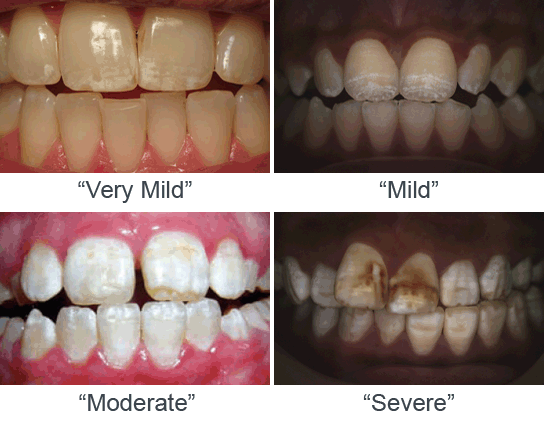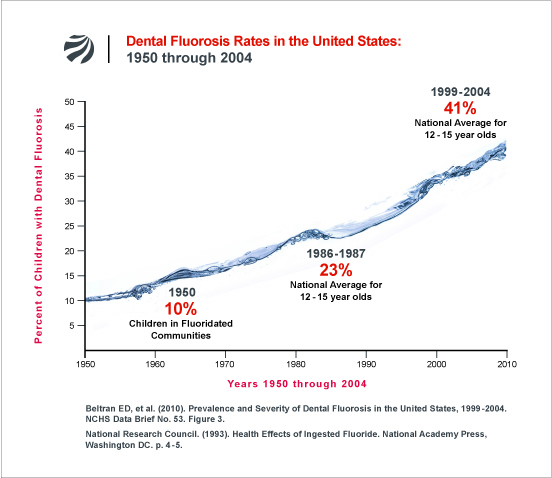Dental Fluorosis on the Rise
Dental Fluorosis
"Common sense should tell us that if a poison circulating in a child's body can damage the tooth-forming cells, then other harm also is likely." - Dr. John Colquhoun (1997).OVERVIEW

Fluorosis is a defect of tooth enamel caused by too much fluoride intake during the first 8 years of life. Although fluorosis can be cosmetically treated, the damage to the enamel is permanent. Common causes of fluorosis include: fluoridated drinking water (particularly during infancy), ingestion of fluoride toothpaste, use of fluoride tablets, and consumption of processed foods made with fluoridated water.
Fluorosis Rates Are on the Rise
Before the widespread use of fluoride in dentistry, dental fluorosis was rarely found in western countries. Today, with virtually every toothpaste now containing fluoride, and most U.S. water supplies containing fluoride chemicals, dental fluorosis rates have reached unprecedented levels. According to the latest national survey by the Centers for Disease Control, 41% of American adolescents now have some form of fluorosis — an increase of over 400% from the rates found 60 years ago. (CDC 2010)What Is Fluorosis?
Dental fluorosis is a defect of the teeth marked by increased porosity of the enamel (a condition known as “hypomineralization“). In the “moderate” and severe forms of fluorosis, the enamel’s porosity increases to such an extent that the teeth can begin to erode and crumble. Teeth with moderate and severe fluorosis also have very pronounced staining which can deeply disfigure a child’s smile.Fluorosis & Self-Esteem
Children with dental fluorosis can suffer significant embarrassment and anxiety over the appearance of their teeth. No matter how much they might brush and floss, the fluorosis stains do not go away. In cases of severe fluorosis, a child may be perceived as having “dirty” or “rotten” teeth, which can cause significant damage to a child’s self esteem and emotional well-being. Even “mild” fluorosis — particularly when present on the front two teeth — can be highly objectionable. Indeed, although fluoride advocates used to downplay the esthetic effect of mild fluorosis, studies since the 1990s have repeatedly found that the general public views such teeth as less pleasing, less attractive, and more likely to cause embarrassment to the affected child than normal, non-fluorosed teeth. It is currently estimated that water fluoridation causes cosmetically objectionable fluorosis in 2 to 12% of the population.Fluorosis: A Visible Sign of Systemic Toxicity
The cosmetic and psychological effects of fluorosis are significant. Dental fluorosis is not limited, however, to cosmetic concerns. The teeth are not the only tissue in the body that accumulate fluoride (the bones, pineal gland, and arteries accumulate it as well). There is no apparent reason, therefore, why fluoride’s effects on the body will be limited to the teeth. As noted by Dr. Hardy Limeback, “it is illogical to assume that tooth enamel is the only tissue affected by low daily doses of fluoride ingestion.” According to the late Dr. John Colquhoun, “Common sense should tell us that if a poison circulating in a child’s body can damage the tooth-forming cells, then other harm also is likely.”In one study, for example, a British researcher found that the cells in the pineal gland (a gland that contains calcified deposits that accumulate fluoride) were just as susceptible to fluoride-induced toxicity as the tooth-forming cells. Unlike the teeth, however, the pineal gland cannot be seen by the naked eye. As noted by the researcher, “The safety of the use of fluorides ultimately rests on the assumption that the developing enamel organ is most sensitive to the toxic effects of fluoride. The results from this study suggest that-the pinealocytes may be as susceptible to fluoride as the developing enamel organ.” (Luke 1997).
Resources:
- Pictures: To see more photos of dental fluorosis, click here.
- Personal Stories: To read letters from individuals and families impacted by dental fluorosis, click here.
- Research: To read research on dental fluorosis, including studies documenting the increase in its prevalence and the impact it can have on a child’s self-esteem, click here.
- Diagnosis: To see the diagnostic criteria for “very mild,” “mild,” “moderate,” and “severe” fluorosis, click here.
- Treatment Options: To learn more about the options for cosmetically treating fluorosis, click here.



All truth passes through three stages.
ReplyDeleteFirst, it is ridiculed.
Second, it is violently opposed.
Third, it is accepted as being self-evident.
Arthur Schopenhauer
Thank You Julie for the information you provide despite the opposition you and Pete face.
ReplyDeleteAre those who oppose able to learn from mistakes?
Fluoride is a poison. Fluoride was poison yesterday. Fluoride is poison today. Fluoride will be poison tomorrow. My research has taken me to the corporation behind water fluoridation. Perhaps you would enjoy the first chapter of Fluoridation Corporation.This is some of the most interesting material I have read on the Corporation behind water fluoridation. FluoridationCorporation
ReplyDelete